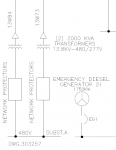mbrooke
Batteries Included
- Location
- United States
- Occupation
- Technician
Not the ones we supply...
we have a Food Lion that’s 480
How Many Square feet? How many amps is the service? Ones around here are 480 volts.
Not the ones we supply...
we have a Food Lion that’s 480
I have done the design of MANY Home Depot retail stores and every one of them that I did use 480v. their prototype design, which they shared with their several architect / engineering firms nationwide, was based on 480v. they used it for lighting (mid 1990s they used 400 watt HID metal halide high bay fixtures - single phase 480 volts so they could put more fixtures on one 20 amp 480 - 1 circuit), parking lot lights (either 400 watt or 1000 watt HID), HVAC and, when required, fire pumps. In some markets, they even purchased their power at medium voltage (5KV nominal) and owned the 5KV - 480V transformer / medium voltage primary switch - when the discount rate for purchasing power at medium voltage offset the cost of transformer ownership.Sounds like two voltages.
stop and shops don’t need 277/480.
Home Depot heat and air system might like 277/480 better.
I have done the design of MANY Home Depot retail stores and every one of them that I did use 480v. their prototype design, which they shared with their several architect / engineering firms nationwide, was based on 480v. they used it for lighting (mid 1990s they used 400 watt HID metal halide high bay fixtures - single phase 480 volts so they could put more fixtures on one 20 amp 480 - 1 circuit), parking lot lights (either 400 watt or 1000 watt HID), HVAC and, when required, fire pumps. In some markets, they even purchased their power at medium voltage (5KV nominal) and owned the 5KV - 480V transformer / medium voltage primary switch - when the discount rate for purchasing power at medium voltage offset the cost of transformer ownership.
Also, most of the newer grocery stores I have designed (Kroger, Fleming's, Kmart super centers, Pick N Save some "local" / "regional" chains, etc) all used 480v - although not often for the refrigeration racks, they learned (the hard way) that replacement motors for the refrigeration equipment, particularly in their rural locations were not readily available in 480 volt.
I don’t disagree with any of your statements.I have done the design of MANY Home Depot retail stores and every one of them that I did use 480v. their prototype design, which they shared with their several architect / engineering firms nationwide, was based on 480v. they used it for lighting (mid 1990s they used 400 watt HID metal halide high bay fixtures - single phase 480 volts so they could put more fixtures on one 20 amp 480 - 1 circuit), parking lot lights (either 400 watt or 1000 watt HID), HVAC and, when required, fire pumps. In some markets, they even purchased their power at medium voltage (5KV nominal) and owned the 5KV - 480V transformer / medium voltage primary switch - when the discount rate for purchasing power at medium voltage offset the cost of transformer ownership.
Also, most of the newer grocery stores I have designed (Kroger, Fleming's, Kmart super centers, Pick N Save some "local" / "regional" chains, etc) all used 480v - although not often for the refrigeration racks, they learned (the hard way) that replacement motors for the refrigeration equipment, particularly in their rural locations were not readily available in 480 volt.
I don’t disagree with any of your statements.
he said it was a strip mall.
we serve many strip malls with two voltages.
the stop and shops here are convenience stores. 120/208.
grocery stores and Lowe’s, home depot, etc, all 480
the stop and shops here are convenience stores. 120/208.
Might be some confusion with that term. "Stop and Shop" is a supermarket chain in the new england area.
Think you were thinking of something like a "Kum and Go"https://en.wikipedia.org/wiki/Kum_&_Go
I don’t disagree with any of your statements.
he said it was a strip mall.
we serve many strip malls with two voltages.
the stop and shops here are convenience stores. 120/208.
grocery stores and Lowe’s, home depot, etc, all 480

I wonder if this would make sense for EV charging, to make it easier for the utility to manage the loads during an emergency evacuation for example.
I wonder if this would make sense for EV charging, to make it easier for the utility to manage the loads during an emergency evacuation for example.


